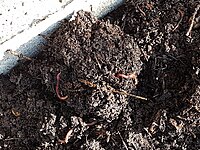
Photo from wikipedia
Bioaerosol and soil organic particles are ubiquitous in the atmosphere, and they are multicomponent and complex in nature [1-4]. Biological particles contribute to a major fraction of coarse mode particles,… Click to show full abstract
Bioaerosol and soil organic particles are ubiquitous in the atmosphere, and they are multicomponent and complex in nature [1-4]. Biological particles contribute to a major fraction of coarse mode particles, especially in the tropical areas, such as the Amazon basin, contributing up to 80% of the particle mass concentration. The way components are mixed in an aerosol sample is referred to as its mixing state [5]. These particles display mixed inorganic (mineral) and organic (soil organic matter, root, microbial) components. The mixing state of particles is crucial to evaluate because it impacts several important environmental processes such as warm and cold cloud formation and radiation budget. Soils are also a mixture of inorganic (mineral) and organic (soil organic matter, SOM) components, which chemically associate with one another. Mixing states in aerosols are accompanied by chemical reactions across solidliquid-gas interfaces. Full characterization of both classes of particles require a multiscale approach. Lower resolution (mm and micrometer scale) imaging provides larger-scale morphology of particles and the overall distribution of pores vs solid phases. When imaging using x-ray computed tomography (XCT), one learns about the 3D distribution of different density phases, including organic vs inorganic. Highresolution imaging is used next for semi-quantitative evaluation of mixing state in aerosol particles, and mineral-SOM associations in soil particles.
Journal Title: Microscopy and Microanalysis
Year Published: 2019
Link to full text (if available)
Share on Social Media: Sign Up to like & get
recommendations!